Memories of Yesteryear
Part 13
A detour to France (continued)
Peugeot
Can you name the oldest motorbike manufacturer in the world? If your answer was anything other than Peugeot then I'm sorry to say that you’re mistaken! The French firm was the first… in fact it’s been around since 1898.
However, Peugeot's heyday and their history of achievements seem so long ago that recent generations must be forgiven for not realising their well-deserved place in motorcycling history. One thing though is certain. Peugeot stood out in the history of the French as well as the international motorbike industry from 1898 right up until the 1950s.
1810s - Making tools, coffee grinders and umbrella ribs
The history of the Peugeot is so significant and broad ranging that the challenge of extracting even the essentials of their past in a single story alarms me. However, the length of this article being limited, I will try to remain concise whilst endeavouring not to leave out anything important.
Let's start with the first stirrings of the brand in 1810 in Beaulieu in the Doubs region, the birthplace of the brand. It began with two men…. Jean-Frédéric and Jean-Pierre Peugeot who transformed their family milling business into a metal working enterprise. They began making tools, coffee grinders, umbrella ribs and various fashion accessories.
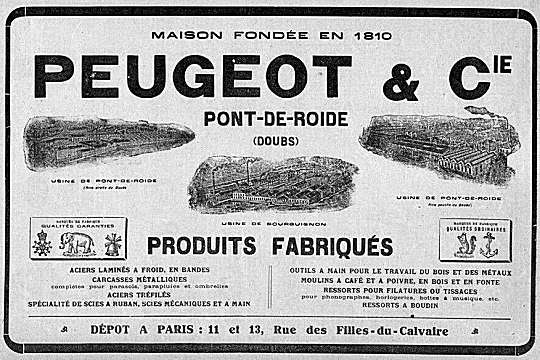
A rare advertisement dating from the 19th century when Peugeot produced various steel products and tools in its Doubs factories
In 1865, Armand Peugeot, the grandson of Jean-Pierre, together with his second cousin Eugène became involved with the running of the company.
In 1882, faced with a burgeoning industrial revolution just across the Channel, they realised the potential of the mobility market and started producing bicycles.
Their first motorised prototype was a tricycle presented at the 1898 Paris exhibition. The engine was a 239.5cc single cylinder made by de Dion Bouton and mounted perpendicular to the rear wheel.
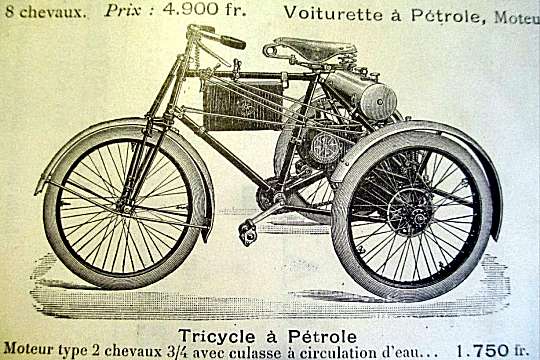
This vintage Dion Bouton advertisement shows the engine design borrowed in 1898 by Peugeot to power their first prototype presented that year at the Paris exhibition
Although rather impractical to use, at the end of the 19th century, tricycles were the first popular motorised vehicle and sold very well due to their relatively low price.
At the end of the 19th century, the fashion was for petrol-powered tricycles, as shown in this extremely rare photo taken on 5 August 1899 at the start of the Belves speed race in the Dordogne region.
1900s - First two wheels, first records
The first real motorbike produced by Peugeot was the 'Motobicyclette', a lightweight machine presented at the 1901 Paris Motor Show. Its Swiss ZL, (Zürcher et Lüthi), engine produced 1½hp, (198cc), was cantilevered on the frame in front of the crankset. The transmission was belt driven and the ultra-light cycle part was a modified and reinforced bike frame.
With the advent of the first 5hp motorbike, marketed in 1903, the engine was located inside the frame, the default position for motorbike designers even today.
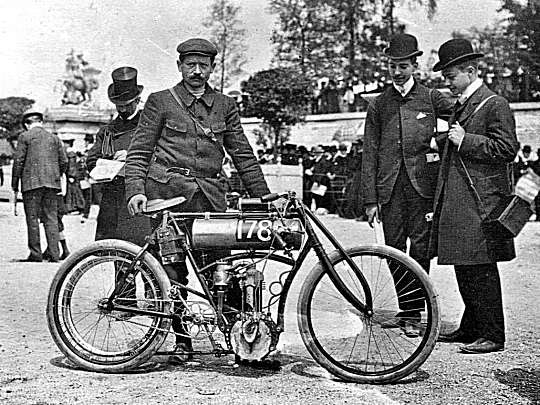
1903 - The rider Lesna posing here next to his three and a half horsepower Peugeot brothers motorbike during the weighing operations at the Tuileries, before the start of the legendary Paris-Madrid race
The range expanded and the engines naturally became more powerful with the introduction during subsequent years of twin-cylinder engines, some of which went on to win numerous competitions.
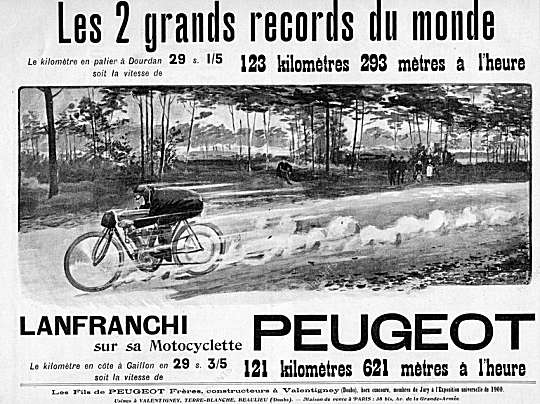
1904 - Vincenzo Lanfranchi set two world records riding his Peugeot V2 prototype: the one kilometre speed record at 123k/h at Dourdan, (south-west of Paris); and the hill-climbing record at Gaillon.
Some of these twin-cylinder engines were sold to Norton, (at the time an embryonic British brand), who used them to win the very first Tourist Trophy in the category, back in 1907.
This creation of Norton, powered by a Peugeot 726cc 4-stroke V-twin engine, with automatic intake and exhaust valves, Brown & Barlow carburettor and a Bosch magneto ignition, produced around 5hp at 4000rpm.
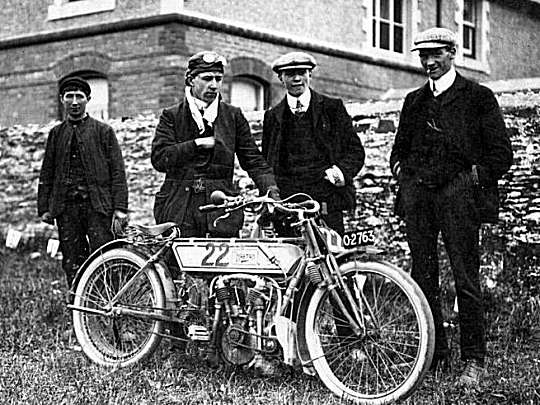
1907 - The Peugeot engine Norton ridden by Rem Fowler who won the first ever Tourist Trophy. A machine without a gearbox, but equipped with a belt drive and pedals for starting and hill climbing assistance. For the record, the pedals used by some competitors were a subject of contention and were banned in 1908.
1910s - The brand gathers more victories
In 1910, Peugeot brought out a light V-twin motorbike that was to be a huge success. This model was called the 'Moto Légère MD' and was equipped with a 333cc 45 degree V-twin with automatic intake valves, direct belt drive, Bosch magneto, Claudel single lever carburettor and Truffault front forks.
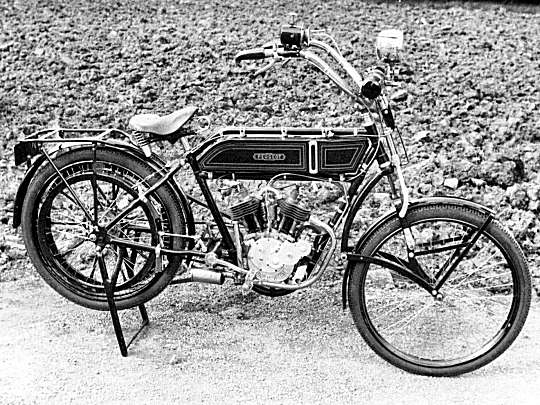
A Peugeot V-Twin in its original touring version pictured here at this French vintage motorbike rally
The little machine had the advantages of being easy to start, easy to handle and very reliable. Moreover, it could reach a very practical speed of 60 km/hour.
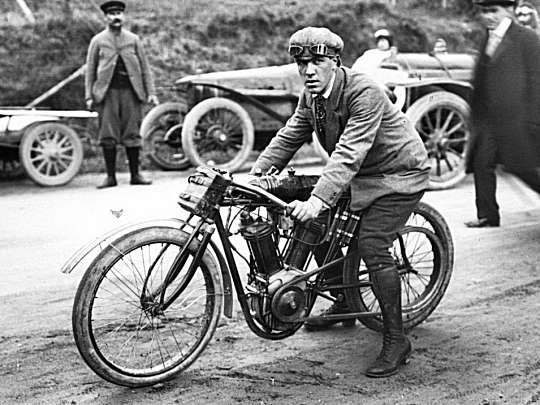
1911 - Ravelli on Peugeot at the Gaillon hill climb
For the year 1913, the bore of this model was enlarged from 70mm to 80 mm, allowing to increase the displacement to 380cc and a speed of 70 km/h.
In just 4 years around 10,000 of this model of machine were sold, making it the most popular French motorbike prior to the First World War.
In April 1913, in the gruelling Paris-Nice regularity race, Peugeot entered a team of riders with even better machines. These models made such a strong impression through their constant victories that they were officially named 'Paris-Nice'.
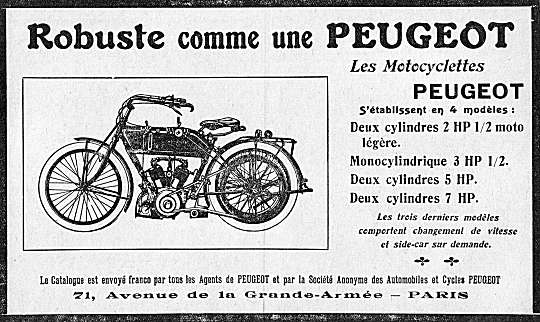
1913 - As this advertisement from that year shows, the brand comprised only four different models.
1914 - First motorcycle with a dual overhead camshaft
But it was in 1914 that Peugeot made its mark by creating the first twin-cylinder engine with double overhead camshaft engine, the 500cc 'M 500' parallel twin. This was a formidable technical feat at the time, which made Peugeot the creator of the most advanced motorbike in the world for many years.
This revolutionary 500cc created quite a stir and gleaned great success in competitions.
The M 500 raced for the very first time at the Circuit de Rambouillet on 5 April 1914. The factory rider Desvaux won; indeed, he was the only 500cc rider to finish the race on what were extremely muddy roads.
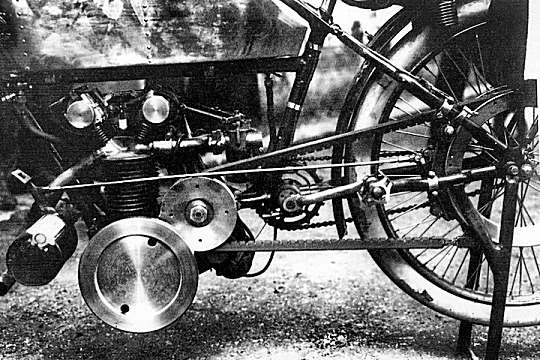
A close up of the transmission of the Peugeot 500 M, with direct belt transmission to the rear wheel and without a clutch. Note the use of a countershaft for the final drive, which also drives the cascade of gears to the cylinder head.
Some three months later, on 14 June, the marque's auto mechanic, Paul Pean, entered the machine in the 'Journée des Records' held in the Fontainebleau forest. That day he smashed two existing world records in the 500cc category. 122.449 km/h (73.47 mph) for the KM, and 121.205 km/h for the Mile.
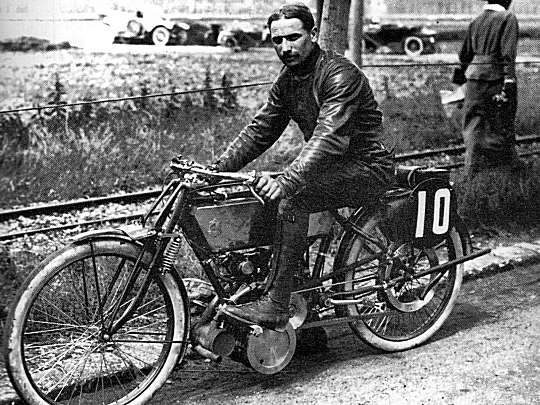
Paul Péan pictured here on the Peugeot DOHC 500cc at Fontainebleau during the 'Journée des Records'
The assassination a few weeks later of Archduke Ferdinand in Sarajevo meant that Peugeot had to abandon the development of the M 500. France was now at war. The brand suddenly had other priorities.
1920s - After the Great War
In the 1920s, Peugeot motorcycles out-paced its cars in terms of technological advancement. However, Peugeot soon split up its various businesses, including its motorbike and car divisions.
In 1926, the Nouvelle Société des Cycles Peugeot was created, bringing together motorbikes and bicycles.
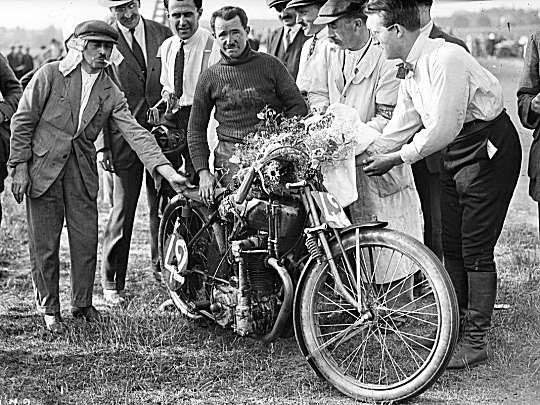
1923 - A new victory for Peugeot: the French Grand Prix in the 500cc category at the Montargis circuit. The winner René Gillard poses for posterity
Until 1926, it has to be said that the Peugeot catalogue did not offer anything very exciting in terms of utility motorcycles. The range consisted mainly of 175cc and 250cc models.
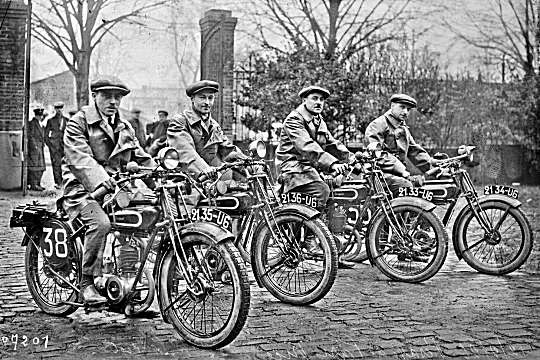
1926 - The Peugeot team on their 175cc single cylinder machines before the start of the famous Paris-Nice race. The four machines entered by the brand finished the race, winning the Touring Club de France trophy; two of them finishing in first place
Mid-20s – Creating a machine
At the 1926 Paris Motor Show, Peugeot revealed a brand new machine: the P104. It was a unit-constructed 350cc side-valve machine, 3 gears and dry sump lubrication. It was Peugeot's first attempt to create a machine with an engine block when the general trend at the time was still towards separate gearboxes.
This machine with its new configuration was not a success, but it didn’t prevent Peugeot from continuing with the block engine and in October 1927 they unveiled the P105, another 350cc machine at the Paris show.
The P107 followed in 1928, arriving on the market when other manufacturers were also emerging in the engine block market, such as Terrot, who produced the excellent HST model exhibited at the October 1929 show.
In the late 20's, Peugeot went to great lengths to improve its image as well as competing with its main rival Terrot. As such, the brand complemented its range with new models such as the 175cc and 220cc side valves produced in 1929.
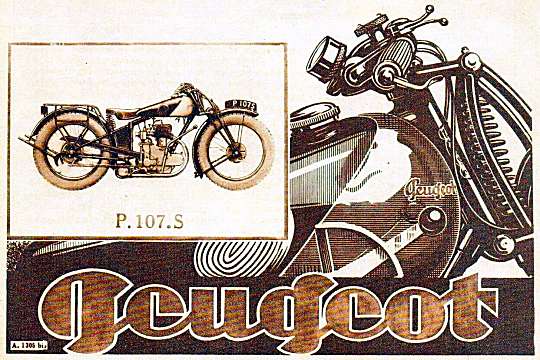
An advert from 1930 for the 350cc P107.S, reportedly the largest single-cylinder motorcycle of the era. The P107 was one of the most well-known bikes of the Peugeot range in the late twenties
Reliable and trouble-free, the P107 with its cleanly designed unit-constructed engine remained in production until 1936. It was the mount in the 1930s of an indefatigable globe-trotter by the name of Robert Sexé, who even rode it across the Sahara.
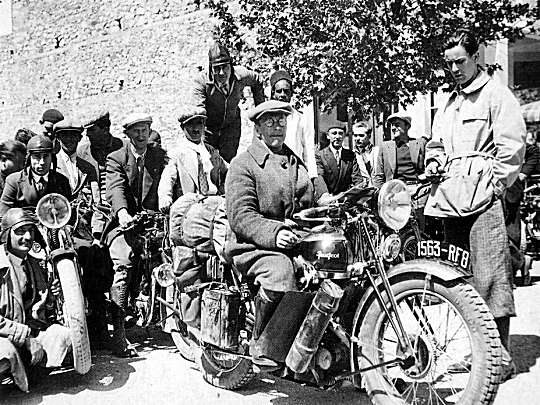
The illustrious traveller and adventurer on two wheels, Robert Sexé, pictured here in 1933 in Sefrou, Morocco, during one of his legendary raids, posing on his Peugeot P107 'Grand Raid’.Until 1931, Robert Sexé remained loyal to Gillet-Herstal before collaborating with Peugeot, carrying out several raids for the brand including 26,000 km in Europe and Africa, 15,000 km by moped across Europe, as well as a tour of France on a moped. He even helped develop a suitable model for the French army.
Its undoubted reliability were not least amongst the reasons convincing the French army to place an order for several thousand P107 machines.
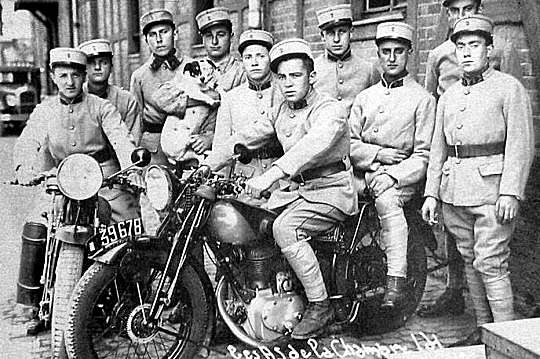
Riders from the 2nd Regiment ‘Chasseurs a Cheval’ pose on their brand new Peugeot P107. Its production for the army continued until 1936.
1931 - Antoine Peugeot makes the brand shine
Another notable event of this decade was the ascent in the summer of 1931 on a P110 model of the mule track linking Chamonix at 1,035m, to the Montenvers hotel at 1,995m. It was ridden by Antoine Peugeot, (Eugène's grandson), at the time one of the main brand ambassadors, whose feat I invite you to follow in the period documentary below:
youtube.com/watch?v=Pi55bNNAUeE
The climb was completed in 1 hour 27 minutes without incident on this small 220cc four-stroke with side valves and three-speed gearbox. It was a standard production bike except for its larger diameter rear sprocket and a protective steel shield beneath the engine.
Another notable success for Peugeot in the 1930s was their victory at the 1933 Bol d'Or in the 250cc category.
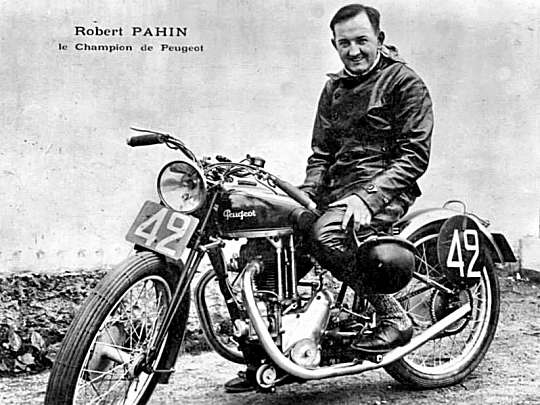
Peugeot racer Robert Pahin, seen here won the Bol d'Or 1933 riding a P108 in the 250cc class, finishing 6th overall.
1934 - Nine world records for the P515
In order to compete against British competition which at the time was producing powerful 'big bikes', the brand exhibited two 500cc four-stroke models at the 1933 Paris Motor Show. These were the P515 with overhead valves and the P517 with side valves; machines which marked the return to the firm of the 500cc category which had been abandoned at the end of the First World War.
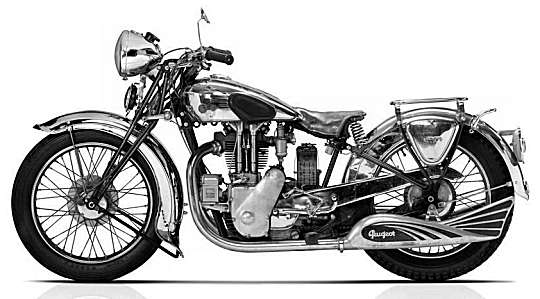
This 1934 model P515 gives us a better understanding of why this robust single cylinder is considered the most beautiful French Production motor cycle of the interwar period. Note the elegant Art Deco aesthetic of the cast aluminium silencers
On Friday 5 October 1934, at 8.36 am, the Peugeot racing team consisting of the brothers Marcel and Robert Pahin, aged 21 and 25 respectively, as well as Camille Narcy, 42, and Pedro Verchère, 25, gathered at the Monthléry speed ring. Their objective was to beat the world 24-hour record held since March 1933 by a 350cc Jonghi.
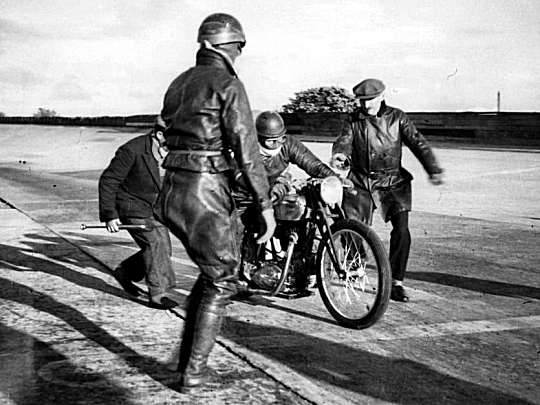
For the P515 and its rider, glory is at the end of the straight line on this legendary day of October 1934 in Monthléry
Despite a leak in the tank and a torrential rain that did not make things easier, twenty-five hours later, these four riders had set an impressive total of nine new world records in the high-powered motorbike category. These included the outstanding 3000 km at an average of 73.42 mph and the 24hour at an average of 73.79 mph.
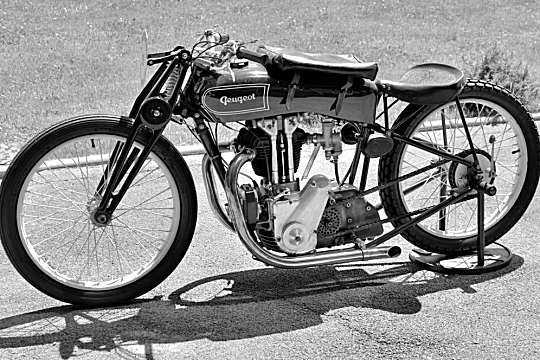
The P 515 was seriously lightened for the attempt. The 2nd and 3rd gears and the kickstart had been removed. The engine was tuned with 22hp at 5000rpm, reaching 150km/h (90mph) using a special 22L tank.
Post WW2
After the Second World War, with difficult economic conditions favouring small engines, Peugeot concentrated on offering a range of utilitarian 125cc two-strokes which were widely distributed to a motorcycle-buying public hungry for basic transportation.
One of these was the P55, released in 1946, a 125cc single-cylinder motorcycle built on the basis of the pre-war P53 100cc model.
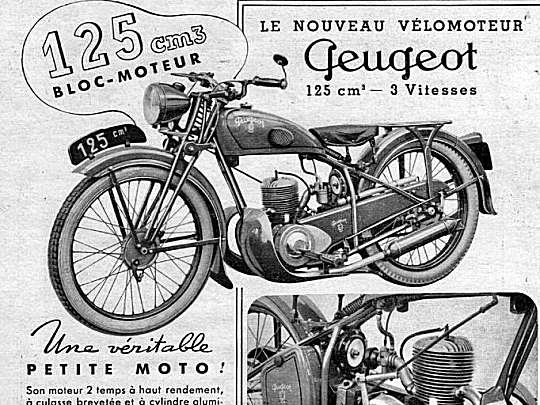
1947 advertisement for the 125cc single-cylinder model
Peugeot achieved huge success by creating a multitude of different models, all derived from the P55. These satisfied all tastes and pockets. There were machines with or without a sliding rear suspension, with parallelogram or telescopic forks, hand or foot shift and in economy or luxury versions.
Even a three-wheeler derived from this model was produced, advertised as the cheapest of all commercial vehicles.
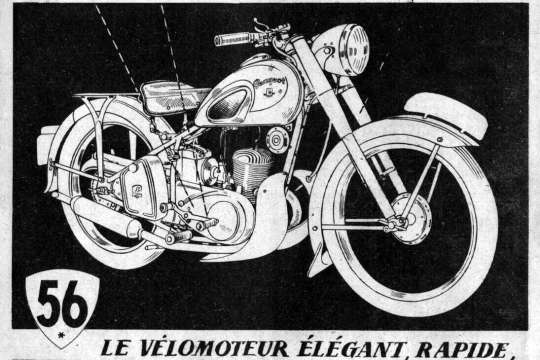
Advertisement for the P56 model manufactured from 1948 to 1960; it was powered by a 122.5cc 2-stroke single cylinder engine and with its 4.6hp it could reach speeds of up to 80 km/h. It could even carry a passenger on its pillion which was an optional extra. The P56 was the first model of the P-series to have 4 gears with a foot-operated selector.
1950s
The early fifties saw some competition successes, in particular with the victory of its factory racer André Bouin on a P176, who won the 175cc category and was ranked overall 5th in the Bol d'Or of 1952.
During this decade, sales of the various 175cc economic models offered to the public proved to be extremely successful.
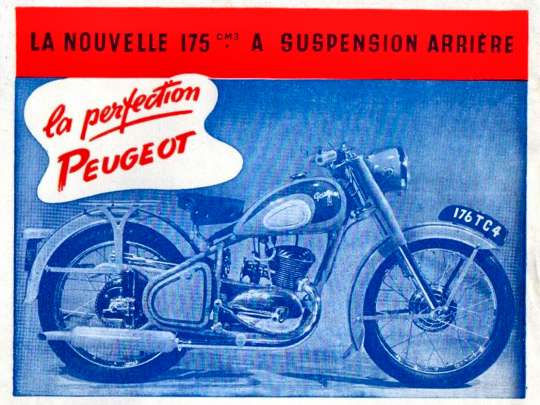
Advertisement for a Peugeot 175cc from the 1950's
This was not the case for the bigger new models in the range. In 1954, the brand decided to produce a 250cc twin, (the 256 TC4). The market had dried up and the public was more interested in small cars. Only 4200 of these 250cc machines were sold between 1954 and 1957.
Then in order to compete with the 350cc Motobécane and Terrot models, Peugeot built a 350cc model named 356TB. Unfortunately this proved to be another failure mainly due to its high fuel consumption.
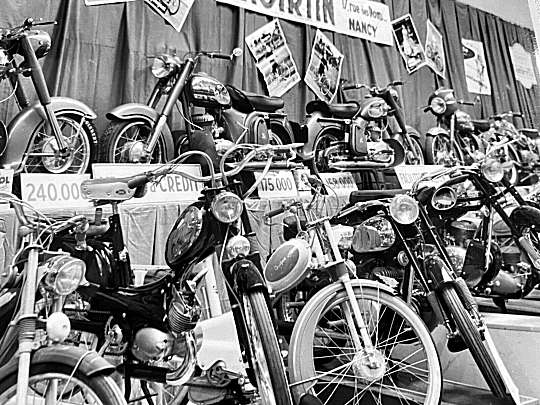
A view of the rich Peugeot range that customers could see in the 'Le Palais de la Moto' shop of the brand's dealer in Nancy
The golden age bids us farewell
This piece summarising the highlights of Peugeot's industrial and sporting past shows how the illustrious French brand was at times pre-eminent in the French motorbike market.
But... every golden age comes to an end and nothing is immutable in this world.
As the 1960s dawned, it was obvious that the popular success of the brand would not survive the overall decline of the motorbike market in France. It became a victim of the combined competition of scooters, popular cars, and other factors, not least of which was the imposition of compulsory motorbike insurance which tripled in price between 1954 and 1957.
But the ‘hammer blow’ was surely the relentless assault of the Japanese motorcycle industry which sounded the death knell for Peugeot bikes.
- Jean-Francois Helias
There will be more from Fanfan for this series!